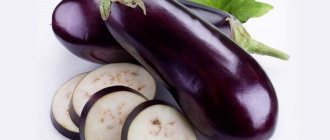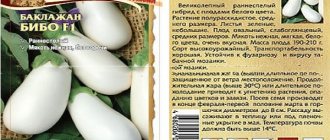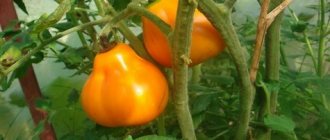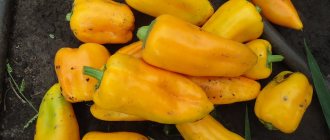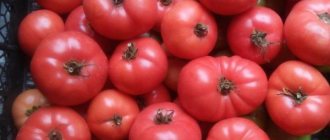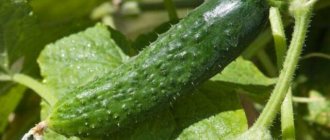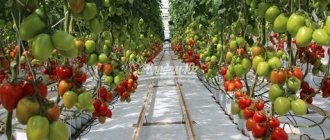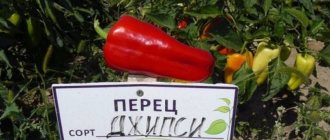There are many varieties of eggplants, among which gardeners can choose those that satisfy them in terms of ripening time, taste, color, and size. For those who appreciate large fruits, breeders have developed the Marzipan eggplant. This is one of the new hybrids that has various positive properties.
The variety was obtained by selection and seed production.
Features of the hybrid
Eggplant Marzipan is a mid-season variety with a ripening period of 120-130 days. It is suitable for growing in open ground, in greenhouses and greenhouses.
The originator gives the following description of the plant:
- bush height up to 1 meter;
- erect plant;
- leaves are large, green;
- The bush blooms with single flowers or flowers collected in inflorescences;
- the fruits are large, fleshy, classically shaped;
- fruit size is up to 16 cm in length, about 7 cm in width;
- the pulp is sweetish, not bitter, pale yellow in color;
- the skin is purple, shiny;
- the seeds are small and there are few of them.
Eggplant Marzipan produces a fairly large amount of fruit. From one plant you can collect over two kilograms of delicious blueberries, each weighing from 300 to 600 grams. The variety is intended for preparing any dishes, including canning. Marzipan is considered one of the best varieties for baking fruits on a wire rack.
Characteristics of eggplant Marzipan F1
Characteristics of eggplant:
- the bush grows up to a meter high;
- the pulp is not bitter, pale cream, sweetish;
- the plant is erect;
- flowers grow in inflorescences and are also single;
- leaves are large, green in color;
- fruit shape is standard;
- average length is about 15 centimeters, width - 8;
- the fruits are fleshy and large;
- eggplants contain few small seeds;
- the peel is shiny, purple.
Fruits grow weighing 300 - 600 grams. During the season, you can harvest approximately 1.5-2 kg of crop from a bush.
Advantages:
- resistance to adverse conditions;
- high taste qualities, Marzipan is one of the most delicious varieties.
Disadvantages and advantages
According to reviews, eggplant Marzipan has the following advantages:
- the ability to grow the plant in any region of the country, and in the southern regions it grows in open ground, and in the northern regions - in greenhouses;
- the fruits have an excellent presentation;
- large fruit;
- the plant tolerates heat and drought well;
- eggplants are delicious, almost without seeds;
- excellent yield.
The disadvantages of eggplant marzipan include:
- demands on lighting: lack of light leads to lightening of the color of the skin;
- fragility of shoots under the weight of fruits;
- demanding on the temperature of the water used for irrigation: when using cold water, the plant sheds ovaries and flowers.
History of variety selection
A representative of the extensive nightshade family, eggplant appeared in Russia in the 17th century, but began to gain great popularity only recently. The exotic fruit gradually became familiar and appeared in fields and private gardens.
Not everyone likes the characteristic bitterness inherent in the taste of eggplant. Selection in recent years has been aimed at eliminating the taste of pulp and breeding varieties resistant to diseases and climate vagaries
Particular attention is paid to the ability of hybrids to grow in open and closed ground
Marzipan F1 is the fruit of the work of seed breeders. The domestic hybrid variety of eggplant is universal: suitable for growing both in the south of the country and in the Far North in greenhouses.
Growing plants
Eggplant Marzipan can be grown in open ground, in a greenhouse. It is grown through seedlings.
Plant seeds are sown in late February - early March in seedling boxes. Seedlings are planted under shelter in May, in open ground in June, after the weather has completely warmed up and the threat of return frost has passed. At the time of transplantation, the seedlings should be 60-70 days old.
Growing
To obtain maximum yield, follow simple recommendations.
Seeds
Seeds need to be prepared in advance before planting:
- Warm up for four hours at +25 degrees.
- Soak the seeds at +40 degrees for 40 minutes.
- Disinfect. To do this, you will need to place the seeds in a weak solution of potassium permanganate and soak for a quarter of an hour.
- To increase germination, rinse off potassium permanganate and place in any stimulating solution for 11 hours.
After all stages of preparation, the seeds are placed in a wet cloth and stored in a warm place until germination.
The soil
To grow seeds, use a special universal soil. It is fully prepared for vegetable growth and includes all the necessary components in the correct ratio.
You can prepare the soil yourself. To do this, you can use one of the following options:
- Mix 2 parts of humus with part of turf soil.
- Combine humus, peat and turf soil in equal proportions.
- Mix equal amounts of humus with soil and coarse sand.
The soil should be slightly acidic or neutral.
Seedling care
Prepared seeds begin to be sown in the second half of March. For seedlings use:
- any plastic containers;
- peat pots.
The volume of the container should not exceed 300 ml. There must be drainage holes so that excess liquid can drain. Fill with fertile soil and then moisten well.
When planting in a cup, the seeds are planted to a depth of no more than one and a half centimeters, one at a time in the center of the container. In the boxes, it is necessary to leave a distance of about 5 centimeters between the seeds.
After planting the seeds you must:
- cover the containers with glass or a transparent bag;
- leave the seeds in a warm place with sufficient light. The temperature should be +22…+26 degrees.
If the temperature conditions are observed, the first shoots will appear after 7-10 days. Immediately after this point you will need:
- monitor daylight hours, which should be 10 hours;
- the temperature at night will be required within +17...+19 degrees;
- Water regularly, but do not over-moisten the soil. Do not allow it to dry out. Water in the morning and only with settled water. When watering with cold liquid, the likelihood of blackleg appearing increases.
If the seeds were planted in a common box, then when the second true leaf appears, they need to be transplanted into separate containers. Before transplanting, water the soil generously. This will help you reach the plant without damaging the roots. After transplantation, the root system will begin to form, so growth will slow down.
Landing
The plant must be planted on the site after 8-12 leaves appear. Eggplants are heat-loving crops, therefore:
- transplanted into the greenhouse in the second half of May;
- in open ground - in mid-June.
Growing seedlings
The Marzipan eggplant variety is planted in late February - early March. Before this period, seeds are planted only if additional lighting is provided.
Before you start sowing, you need to prepare everything you need. You should start by choosing a soil - you can prepare it yourself or purchase a ready-made substrate at a country store. The latter option has all the necessary substances and microelements.
When making your own soil, prepare a mixture of one part sand, three parts humus and four parts peat. Add a spoonful of superphosphate and a glass of wood ash to a bucket of soil.
Planting boxes are filled two-thirds with soil and watered. Then grooves are made 0.5 cm deep. The seeds are placed in them at a distance of 1-2 cm from each other. To speed up germination and prevent drying out of the upper layers of the soil, the boxes are covered with glass or film.
Seed germination occurs at a temperature of 25 degrees.
At the cotyledon leaf stage, it is recommended to pick seedlings in separate containers. During transplantation, you should be extremely careful not to damage the root system. According to reviews, Marzipan F1 eggplants are difficult to restore damaged roots.
Initially, eggplants have enough nutrients contained in the soil. As the seedlings grow and develop, intensive feeding is carried out. It is best to give preference to complex fertilizers for seedlings. They are used according to the instructions.
Two weeks before planting in a permanent place, the seedlings are hardened off, gradually accustoming them to fresh air. You should start with 15 minutes, gradually increasing the time the seedlings stay in direct sun.
Growing and care
Eggplants are watered with warm, settled water every 3-4 days or every week. Apply water to the roots.
You can’t use cold water, because it can cause the bushes to drop their fruits.
At the beginning of the season, about 4 liters of liquid per 1 square meter is required. m, and during fruit ripening - up to 12 liters.
Apply 3-4 fertilizing per season:
- 10 days after transplanting to a permanent place, pour a solution of 1 liter of mullein into a bucket of water or prepare a urea solution according to the instructions.
- During the flowering period, feed with a weaker solution of mullein (1 glass per bucket of water) with the addition of superphosphate and potassium chloride or other potassium supplement.
- During the period of fruit ripening, a solution of a mineral complex for nightshades is prepared.
Feeding with manure is prohibited. It can cause burns to the roots, and in addition, its excess leads to an overdose of nitrogen and a decrease in yield.
In the greenhouse, the bushes require shaping. Remove excess ovaries, leaving up to 4 of the strongest. Also cut off the lower leaves and shoots up to the first fork.
Loosen the soil and weed out weeds.
Landing at a permanent place
Eggplants are plants that love light and warmth, so they are planted when the temperature remains at 17-20 degrees. If it drops to 15 or rises above 30, then the plants shed buds.
According to the description of the variety and characteristics of eggplant Marzipan, before planting the seedlings in a permanent place, it is necessary to carry out preparations. A day before the planned planting, the bushes are watered abundantly. Repeat watering immediately before planting.
Plants are planted according to the scheme of three bushes per square meter. A distance of at least 60 cm is maintained between the rows, and the seedlings are transplanted together with a lump of earth without damaging the root system.
Characteristics of the Marzipan variety
The bush of the plant is vigorous with cylindrical or rounded fruits. Each bush grows two to three eggplants of regular geometric shape, weighing from 0.4 to 1.0 kg. Eggplant has a vigorous root system, penetrating to a depth of 40 cm to 1 m.
Advantages of the variety:
- resistance to adverse weather conditions;
- the yield from 1 bush is 1.5–2 kg;
- excellent taste;
- beautiful and neat appearance of the fruit.
Important: The plant is light-loving. Develops and accelerates fruiting with short but bright daylight hours
Mid-season eggplant varieties, which include Marzipan, take longer to form fruits, but are more resistant to untimely watering and dry periods.
Plant care
According to the description, Marzipan eggplants do not require special care. These plants do not like excessive watering - 5 liters of water per square meter is enough. Water the beds once a week. After watering, the soil is loosened. If plants are grown in a greenhouse, it should be ventilated.
During growth, the bushes need to be shaped. Usually eggplants grow in 2-3 stems, all other shoots are removed. The remaining shoots are tied to a support. Also remove all leaves that shade the stems and flowers.
When growing eggplants in the northern regions, the bushes are pinched at a height of 30-35 cm. In this case, no more than six ovaries are left on one plant.
Features of growing eggplant
Most often, a weak harvest is caused by improper care of Marzipan bushes. The most common mistakes:
- with a lack of sunny color or an abundantly overgrown green mass, the fruits do not acquire a beautiful rich purple color and remain light or brown. To fix this, some of the leaves on the tops of the bushes are removed;
- uneven watering of eggplants of the Marzipan F1 variety in hot weather leads to the formation of cracks in the fruits;
- if you use cold water when watering, the plant may shed its flowers and ovaries;
- curling of eggplant leaves into a tube and the formation of a brown border along their edges means a lack of potassium;
- with a lack of phosphorus, the leaves grow at an acute angle relative to the stem;
- if the crop lacks nitrogen, the green mass takes on a light shade.
Proper care of eggplant Marzipan F1 promotes the full development of the plant and ensures a bountiful harvest throughout the season.
General rules of care
To get a good harvest, you must follow the following care rules:
- Throughout the summer, it is necessary to loosen the soil so that it does not become compacted. They especially carefully monitor the soil after rains and waterings.
- The bed with bushes should always be slightly damp. To get Marzipan eggplants, as in the photo, according to reviews, you should water them once a week. This variety is not afraid of drought, but it also cannot tolerate the dryness of the earthen clod.
- During the entire period of fertilizing of plant development, it is necessary to carry out three feedings. The first is done ten days after planting the seedlings, the second - two weeks after the first, and the third time the bushes are fed during the period when fruiting begins.
- Eggplants are plants that grow adventitious roots. This helps increase productivity. To stimulate the formation of roots, it is necessary to hill up the plants.
- The beds must be weeded and the bushes inspected for pests and diseases.
Characteristics of the variety
Eggplant is native to the tropics and does not tolerate temperature fluctuations. If it gets cold at night to +15 °C, Marzipan F1 stops growing. At +5 °C the bush dies.
Important! Extreme heat for this variety is above +35 °C. Experienced gardeners do not recommend cultivating the Marzipan F1 eggplant variety in areas where summer temperatures are above +40 °C
Productivity and fruiting
Mid-season Marzipan F1 is grown through seedlings. From sowing the seeds to the first ripe eggplants, it takes from 120 to 130 days. In warm climates, the bushes bear fruit until the end of October.
It is possible to remove about 2 kg of fruit from a Marzipan F1 bush, with an average weight of one eggplant ranging from 300 to 600 g. The crop is extremely demanding on soil quality. With good soil aeration and regular fertilizing, the fruits grow more than 1 kg. Even the presence of crust on the surface of the earth affects the yield. Regular loosening improves the condition of the roots.
The root system of eggplant is less developed than the above-ground part. Large fruits can weigh down the bush so much that they turn it out of the ground. The abundant harvest of Marzipan F1, pouring on the stems, requires support and garter.
Area of application of fruits
The pulp of Marzipan F1 eggplant has a surprisingly mild taste. Which reflects its “sweet” name. The bitterness characteristic of eggplants is completely absent, which allows the vegetable to be used in the preparation of any dishes and simplifies the preparation of fruits for the winter. The variety is also valued for its lack of obvious seeds.
The shelf life of collected fruits is more than a month. The dense peel allows you to transport Marzipan F1 without losing its presentation.
Resistance to diseases and pests
According to the characteristics and description of the variety, Eggplant Marzipan is resistant to most diseases and is rarely damaged by insects. According to gardeners, there is still a disease typical for this hybrid.
Blackleg is a root collar fungus caused by soil contamination
Infection of the stem can destroy the entire bush, so it is important to carry out preventive disinfection of the soil. The soil for planting seedlings should be calcined in the oven
Like all nightshades, Marzipan F1 is threatened by the Colorado potato beetle. After the potato tops dry out, the pests move to the eggplants. At this time, chemical treatment of the bushes is impossible, since the fruits are already beginning to ripen. They protect plantings from beetles using mechanical methods: collecting by hand, shaking off leaves in containers. Infestation can be prevented by placing a fine mesh over the plantings.
Advantages and disadvantages of the variety
Based on reviews of eggplant Marzipan F1, it is possible to make a list of its beneficial qualities:
- Cultivation in different climates, thanks to the versatility of the variety (for greenhouses and open ground).
- Resistant to short-term soil drying and heat.
- Large fruit and good taste of eggplants.
- Stable yield.
The disadvantage is the inability to use seeds from grown fruits for breeding the variety in the future. Planting material must be purchased every year. The hybrid variety Marzipan F1 does not transmit its characteristics through seed propagation.
Important! The variety is extremely light-loving. With a lack of sunlight, the peel does not acquire a characteristic shade: it may turn brown or remain light.
Diseases, pests
Eggplants belong to the nightshade family, which includes tomatoes. These plants suffer from the same diseases.
Late blight is a widespread fungal disease that is characterized by the appearance of rusty spots on the foliage. In dry weather, the leaves dry out and fall off, and in rainy weather they become covered with plaque and rot. To combat the disease, copper sulfate and Bordeaux mixture are used. Plants are treated after sunset. Prevention of late blight involves burning diseased plants after harvest. Treating the bushes with a garlic solution helps a lot - two hundred grams are infused in three liters of water for three days. Then the solution is diluted with water in a 1:1 ratio.
Eggplants can become infected with mosaic. This is a disease of a viral nature, in which the leaves become deformed - they become covered with pale green patterns. Yellow spots appear on the fruits. The affected bushes are removed, the entire instrument is processed. Healthy-looking plants must be treated with an antiviral drug. To prevent mosaic, treat plants with a soap solution prepared from 20 grams of laundry soap diluted in a liter of water.
Eggplants are often affected by aphids. It sucks out the sap of the plant, causing the leaves to curl and the bush to die. To combat aphids, chemicals or folk remedies are used. Ash tincture helps to cope with the pest: a glass of ash is mixed with 10 liters of water and a spoonful of green soap. The composition is allowed to brew for a day, then the eggplants are treated with it. To protect plants from aphids, it is necessary to ventilate the greenhouse, and also carry out preventive treatments of the bushes with chemicals or an ash solution every two weeks.
In dry weather, plants can be damaged by spider mites. Pests feed on cell sap. To combat it, plants are treated with special chemicals strictly according to the instructions. To prevent plant infection, eggplants are sprayed with water in hot, dry weather. This procedure is performed in the morning and evening.
How to germinate seeds?
Normally, eggplant seeds are flat and light brown in color. They are placed in a bowl of water and washed well. If the seeds sink to the bottom of the bowl, then they are suitable for germination. If they surface, they are discarded. Normally, 87% of seeds are discarded.
Typically, the manufacturer treats the material for sowing with a disinfectant, but gardeners still treat the seeds with a solution of potassium permanganate. Potassium permanganate kills pathological microflora and fungus. This is a preventive measure against viral and infectious diseases.
Next, the seeds need to be “awakened”. They are saturated with vitamin and mineral complexes. Use a solution of table salt or a biostimulator of growth, such as Epin.
Take 0.025 ml of the drug per 1 liter of water. The material is kept in the solution for 30 minutes. Treatment in saline solution lasts 2 hours. Seeds are kept in cold melt water for 12 hours.
To ripen the seeds, use a damp cloth. Material for sowing is wrapped in it. The napkin needs to be moistened. If you plan to plant a lot of eggplants, then place the seeds in a shallow container.
Holes are made in it and a container is placed over a basin of water. The water will evaporate and moisten the seeds. The optimal temperature for ripening is 14 C.
View this post on Instagram
Publication from AUCHAN Gagarinsky (@auchan_gagarinsky) Aug 11, 2021 at 2:16 PDT
Sprouts appear within a week. They don’t wait for them to grow, they sow immediately. Long shoots may break. Sowing is carried out in individual containers. Use soil with peat, sand and black soil. Soil temperature 25 C. Further ripening of seeds is carried out at a temperature of 30 C.
A lamp is installed above the containers with seedlings. It is recommended to use a fluorescent lamp or fluorescent device. Moisten the seeds once every 10 days.
According to gardeners, the seedlings are not fibrous. The stems are thin with numerous articular areas. They should be handled carefully so as not to break them. They are very fragile.
It is recommended to irrigate the soil once with an ash solution. The containers are covered with film. It is removed once a day to ventilate the soil. Otherwise, a fungus will form on its surface:
- After 14 days, sprouts will appear. The film is removed. The temperature is reduced to 25 C. The rest of the care is left as before. The lights are not turned off for 14-16 hours. This is especially true for the northern regions;
- after 2 leaves appear, the temperature regime is changed. At night the indicator is reduced to 16 C;
- with the appearance of 4 leaves, the daytime temperature is reduced to 20 C, the night temperature to 15 C. The regime is maintained until day 55;
- By this time the bush is taking shape. It grows 20 cm. Up to 10 leaves appear on it.
More on the topic: What care does a long purple eggplant require?
Harvesting
As you can understand from the description and photo, Marzipan eggplants give a good harvest. When collecting it, the timing of fruit ripening should be taken into account. Harvesting too early will produce bitter fruits, while harvesting too late will have too large seeds and hard pulp. Therefore, the fruits are harvested during the period of technical ripeness, about a month after flowering. A clear sign of fruit readiness for harvesting is the bright, pronounced gloss of the fruit with a characteristic dark purple color.
Vegetables are cut with scissors or pruning shears along with the stalk. This procedure should be performed carefully so as not to damage the bush. The collected vegetables are eaten immediately, since they cannot be stored for a long time - during storage, eggplants become soft, their skin wrinkles. Vegetables can retain their appearance and taste for no longer than three weeks if stored in the refrigerator.
Harvest and storage
Under suitable conditions, the fruits retain their appearance and taste for several months. Eggplants reach technical ripeness 1-1.5 months after flowering. The fruits are painted a rich purple color. The pulp becomes elastic and the seeds turn white.
The fruits ripen gradually, so they are collected selectively, checking the degree of ripeness every three days. Cut with pruning shears or a well-sharpened knife, leaving 3 centimeters of the stalk.
To store eggplants, wipe them with a dry towel and place them in the basement. Room temperature from 0 to +2 degrees. They are stored on the floor for two weeks, arranged in a maximum of two layers. After three weeks, undamaged, hard fruits are selected and wrapped in paper. Then they are laid out on straw and covered with thick cloth. If all conditions are met, you can enjoy the taste of fresh eggplant for 3 months.
https://youtube.com/watch?v=1E_VFcy2w0g
Eggplant Marzipan is a young domestic variety intended for cultivation in difficult weather conditions: from heat and drought in the south to the harsh northern regions. The hybrid shows its qualities well in closed ground conditions and in open beds. Marzipan F1 has an undoubted advantage over classic varieties - its pulp is not bitter.
